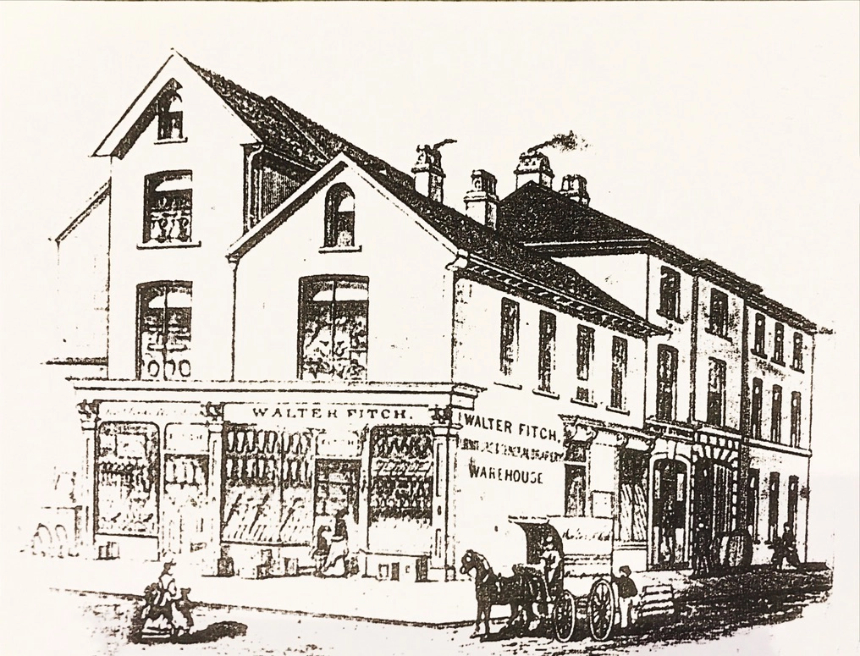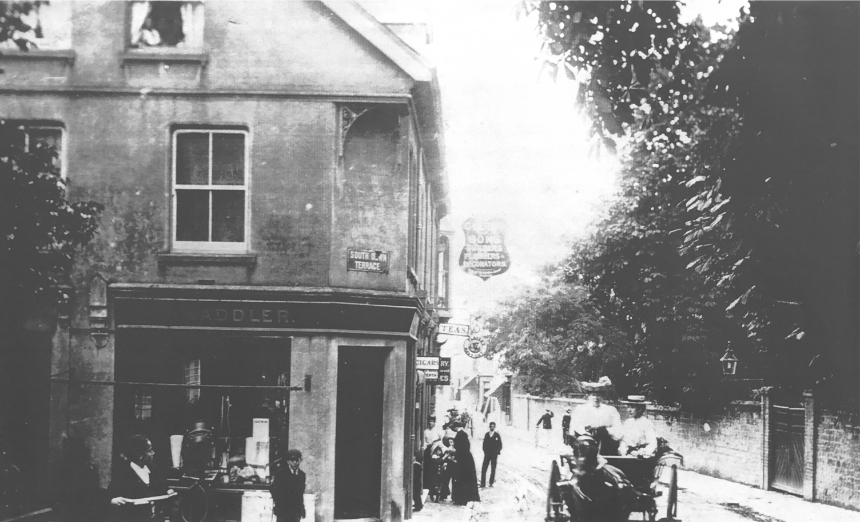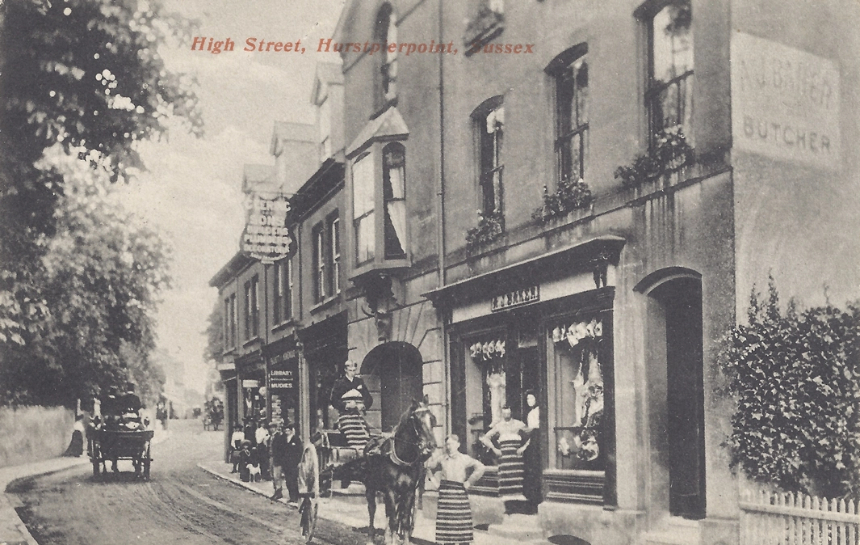
South Down Terrace
History
The Great Fire of Hurstpierpoint
On Friday 27th January 1882 Hurstpierpoint witnessed one of the most dramatic days of its history. The building known as Holdens, now the Nationwide Building Society, and the three adjoining houses were extensively burnt down. This was Walter Fitch’s General Grocery, Drapery Store and Warehouse. The scene over the next few days was reported in the Sussex Daily News. These reports were collated by Ian Nelson and are abridged here.
At 5:15 in the morning a carpenter named Windus, and Mr Waller, an ex- policeman, raised the alarm. Flames were already bursting out of the east windows of the store and warehouse and threatening to burn the North House, property of Lawrence Smith, a retired Lawyer. North House is now divided into the three properties that are The Odd Corner, Chichester House and Bielside.
‘By the time the inmates of the surrounding houses and the employees at the shop could be roused, the fire had obtained such a hold as to defy the ordinary means of extinguishing.’
Besides the grocery and drapery goods in Mr Fitch’s store, there were quantities of wines and inflammable spirits in the cellar, along with oils and 8 lbs of gunpowder on the first floor! Little could be done to save it, so efforts centred on saving Lawrence Smith’s house to the east, and Bank House to the west, the latter, now West End Cottage, belonged to Mr Pierce.
At the time, Hurst had no fire brigade. Brighton Police, who ran the Volunteer Fire Service, and Burgess Hill Waterworks were sent Telegrams! A contingent of the Volunteer Fire Brigade caught a train to Hassocks, and horse drawn engines arrived soon after them.”
In command was Lieut. Hayley who organised all the work and managed to resolve the need of more water pressure. The men began to make an appreciable impression on the fire. The prevailing wind was a very calm South Easterly, and so with diligent application of water, and removal of slates by William Davey and others, they managed to save Lawrence Smith’s house. This was not without incident. William Davey and others had “marvellous escapes”. At 6.15 a.m. explosions occurred, which blew up a greater part of the roof, and then the fire began to rage with renewed activity. The east end of the shop having burnt out, the wall fell with a tremendous crash, knocking over the ladders on Mr. Smith’s house.
Villagers flocked to help clear timber, furniture and other things of the adjoining neighbours. Although saving Mr Pierce’s house appeared futile, the timely appearance and bravery of the fire brigade accomplished this, despite a second huge explosion that was heard in neighbouring villages that rocked the scene, shattering windows of other High Street properties. Sub-Engineer Lacroix had one foot on the roof of Mr Pierce’s House, supporting himself against the chimney while cooling the house with water when the explosion occurred.
“Undeterred, however, the men kept at work, and within half an hour the flames were under command. Such a commotion has not been caused at Hurst for many years the fire having lit the country for miles around and bringing crowds to the scene.”
The cause of the fire is not known and the building was not fully insured. Both landlord and tenant suffered heavy losses. However, “…thanks to the mildness and direction of the wind, the assiduous working of the Brigade, and the useful help of the inhabitants, the fire was confined to the building. This is an entire wreck, the bare walls standing in a few places.”
Danger was considered to be over some time before noon and the Volunteer Fire Brigade returned with their engine by road, reaching Brighton shortly before 3pm. However, at 5.15pm the fire was still burning. “Firemen and Salvage Corps are about the ruins.”
At 8.30pm, …still burning, the firemen, deluged the smoking ruins with hoses. About every ten minutes smouldering heaps broke out again and again. Arrangements were therefore made for Superintendent Farr, Engineer Dobson, Sub-engineer Smith, and Firemen Slater & Smith to remain on duty all night. They would review the situation in the morning.
“P.C. Wood, stationed at Hurst, was soon on the scene, and after telegraphing to his superiors for relays of men, worked with energy in various ways. On the arrival of the Superintendent, Sergeant and four Constables they carried out their duties in a most exemplary manner at their respective posts.”
Firemen, policemen, and willing volunteers did their utmost to render assistance where needed. The shell of the building looked very unsafe and was shored up in places and guarded by three constables all night.
A daring feat was accomplished by a young man who walked along the top of a nine-inch wall to run a rope round a stack of chimneys. These were soon pulled down.
The following day:
To the Editor of the Sussex Daily News.
Sir, – With reference to the fire which took place in the premises adjoining my house, I do not think that I ought to pass over without remark the extraordinary exertions which were made by my friends, neighbours, and Fire Brigade men to save my house. Had the property been their own I feel sure that they could not have worked more than they did to the very limit, and one would have said beyond the limit of their endurance. I could mention the names of some four or five but where all did their utmost, it is, perhaps, invidious to do so. It will, I think be a relief to the feelings of others as well as of myself that such exertions involving such dangers should not be passed over in silence, and I hope all will accept my most hearty thanks for their great kindness.
Yours,
LAWRENCE SMITH.
North House, Hurstpierpoint, January 28th, 1882
Rebuilt as South Down Terrace, in 1891 it is recorded as being owned by John Smith, Saddler and harness maker. While he repaired leather satchels and attaché cases and restrung tennis rackets, the building was in full use; Geerings; builders, plumbers and decorators, Ashby’s confectionary and tobacconist and the South Downs Tea rooms (possibly the first fish and chip venue in the village!) , not forgetting Mr Baker the Butcher, with an abattoir to the rear of the arched doors.
In the aftermath of this tragedy, and miraculous absence of lives loss, the kindness and charitable help to those who were affected was nothing less than we continue to expect in our village. But what did happen next?… well, that’s another story!
Visit more of the History of Hurst and its High Street on The Society’s :
Hurstpierpoint Heritage Trail.

